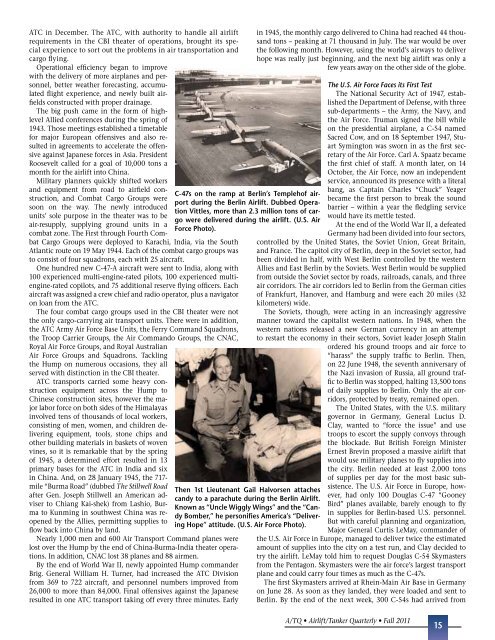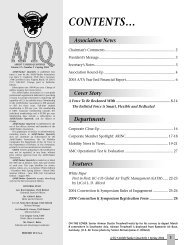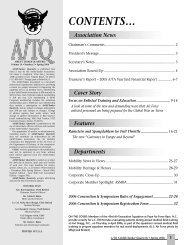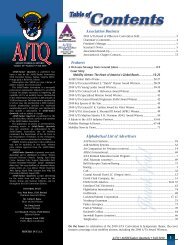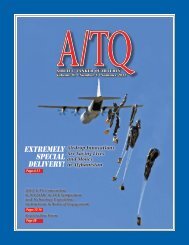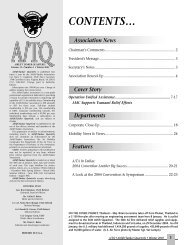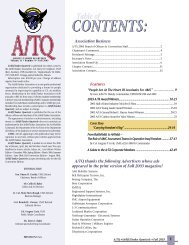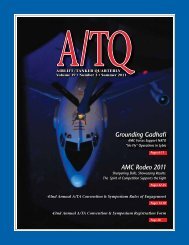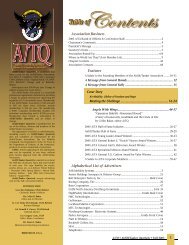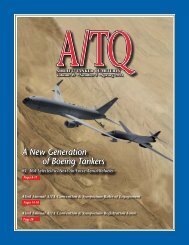A Salute to the A/TA Industry Partners - Airlift/Tanker Association
A Salute to the A/TA Industry Partners - Airlift/Tanker Association
A Salute to the A/TA Industry Partners - Airlift/Tanker Association
Create successful ePaper yourself
Turn your PDF publications into a flip-book with our unique Google optimized e-Paper software.
ATC in December. The ATC, with authority <strong>to</strong> handle all airliftrequirements in <strong>the</strong> CBI <strong>the</strong>ater of operations, brought its specialexperience <strong>to</strong> sort out <strong>the</strong> problems in air transportation andcargo flying.Operational efficiency began <strong>to</strong> improvewith <strong>the</strong> delivery of more airplanes and personnel,better wea<strong>the</strong>r forecasting, accumulatedflight experience, and newly built airfieldsconstructed with proper drainage.The big push came in <strong>the</strong> form of highlevelAllied conferences during <strong>the</strong> spring of1943. Those meetings established a timetablefor major European offensives and also resultedin agreements <strong>to</strong> accelerate <strong>the</strong> offensiveagainst Japanese forces in Asia. PresidentRoosevelt called for a goal of 10,000 <strong>to</strong>ns amonth for <strong>the</strong> airlift in<strong>to</strong> China.Military planners quickly shifted workersand equipment from road <strong>to</strong> airfield construction,and Combat Cargo Groups weresoon on <strong>the</strong> way. The newly introducedunits’ sole purpose in <strong>the</strong> <strong>the</strong>ater was <strong>to</strong> beair-resupply, supplying ground units in acombat zone. The First through Fourth CombatCargo Groups were deployed <strong>to</strong> Karachi, India, via <strong>the</strong> SouthAtlantic route on 19 May 1944. Each of <strong>the</strong> combat cargo groups was<strong>to</strong> consist of four squadrons, each with 25 aircraft.One hundred new C-47-A aircraft were sent <strong>to</strong> India, along with100 experienced multi-engine-rated pilots, 100 experienced multiengine-ratedcopilots, and 75 additional reserve flying officers. Eachaircraft was assigned a crew chief and radio opera<strong>to</strong>r, plus a naviga<strong>to</strong>ron loan from <strong>the</strong> ATC.The four combat cargo groups used in <strong>the</strong> CBI <strong>the</strong>ater were not<strong>the</strong> only cargo-carrying air transport units. There were in addition,<strong>the</strong> ATC Army Air Force Base Units, <strong>the</strong> Ferry Command Squadrons,<strong>the</strong> Troop Carrier Groups, <strong>the</strong> Air Commando Groups, <strong>the</strong> CNAC,Royal Air Force Groups, and Royal AustralianAir Force Groups and Squadrons. Tackling<strong>the</strong> Hump on numerous occasions, <strong>the</strong>y allserved with distinction in <strong>the</strong> CBI <strong>the</strong>ater.ATC transports carried some heavy constructionequipment across <strong>the</strong> Hump <strong>to</strong>Chinese construction sites, however <strong>the</strong> majorlabor force on both sides of <strong>the</strong> Himalayasinvolved tens of thousands of local workers,consisting of men, women, and children deliveringequipment, <strong>to</strong>ols, s<strong>to</strong>ne chips ando<strong>the</strong>r building materials in baskets of wovenvines, so it is remarkable that by <strong>the</strong> springof 1945, a determined effort resulted in 13primary bases for <strong>the</strong> ATC in India and sixin China. And, on 28 January 1945, <strong>the</strong> 717-mile “Burma Road” (dubbed The Stillwell Roadafter Gen. Joseph Stillwell an American adviser<strong>to</strong> Chiang Kai-shek) from Lashio, Burma<strong>to</strong> Kunming in southwest China was reopenedby <strong>the</strong> Allies, permitting supplies <strong>to</strong>flow back in<strong>to</strong> China by land.Nearly 1,000 men and 600 Air Transport Command planes werelost over <strong>the</strong> Hump by <strong>the</strong> end of China-Burma-India <strong>the</strong>ater operations.In addition, CNAC lost 38 planes and 88 airmen.By <strong>the</strong> end of World War II, newly appointed Hump commanderBrig. General William H. Turner, had increased <strong>the</strong> ATC Divisionfrom 369 <strong>to</strong> 722 aircraft, and personnel numbers improved from26,000 <strong>to</strong> more than 84,000. Final offensives against <strong>the</strong> Japaneseresulted in one ATC transport taking off every three minutes. EarlyC-47s on <strong>the</strong> ramp at Berlin’s Templehof airportduring <strong>the</strong> Berlin <strong>Airlift</strong>. Dubbed OperationVittles, more than 2.3 million <strong>to</strong>ns of cargowere delivered during <strong>the</strong> airlift. (U.S. AirForce Pho<strong>to</strong>).Then 1st Lieutenant Gail Halvorsen attachescandy <strong>to</strong> a parachute during <strong>the</strong> Berlin <strong>Airlift</strong>.Known as “Uncle Wiggly Wings” and <strong>the</strong> “CandyBomber,” he personifies America’s “DeliveringHope” attitude. (U.S. Air Force Pho<strong>to</strong>).in 1945, <strong>the</strong> monthly cargo delivered <strong>to</strong> China had reached 44 thousand<strong>to</strong>ns – peaking at 71 thousand in July. The war would be over<strong>the</strong> following month. However, using <strong>the</strong> world’s airways <strong>to</strong> deliverhope was really just beginning, and <strong>the</strong> next big airlift was only afew years away on <strong>the</strong> o<strong>the</strong>r side of <strong>the</strong> globe.The U.S. Air Force Faces its First TestThe National Security Act of 1947, established<strong>the</strong> Department of Defense, with threesub-departments – <strong>the</strong> Army, <strong>the</strong> Navy, and<strong>the</strong> Air Force. Truman signed <strong>the</strong> bill whileon <strong>the</strong> presidential airplane, a C-54 namedSacred Cow, and on 18 September 1947, StuartSyming<strong>to</strong>n was sworn in as <strong>the</strong> first secretaryof <strong>the</strong> Air Force. Carl A. Spaatz became<strong>the</strong> first chief of staff. A month later, on 14Oc<strong>to</strong>ber, <strong>the</strong> Air Force, now an independentservice, announced its presence with a literalbang, as Captain Charles “Chuck” Yeagerbecame <strong>the</strong> first person <strong>to</strong> break <strong>the</strong> soundbarrier – within a year <strong>the</strong> fledgling servicewould have its mettle tested.At <strong>the</strong> end of <strong>the</strong> World War II, a defeatedGermany had been divided in<strong>to</strong> four sec<strong>to</strong>rs,controlled by <strong>the</strong> United States, <strong>the</strong> Soviet Union, Great Britain,and France. The capi<strong>to</strong>l city of Berlin, deep in <strong>the</strong> Soviet sec<strong>to</strong>r, hadbeen divided in half, with West Berlin controlled by <strong>the</strong> westernAllies and East Berlin by <strong>the</strong> Soviets. West Berlin would be suppliedfrom outside <strong>the</strong> Soviet sec<strong>to</strong>r by roads, railroads, canals, and threeair corridors. The air corridors led <strong>to</strong> Berlin from <strong>the</strong> German citiesof Frankfurt, Hanover, and Hamburg and were each 20 miles (32kilometers) wide.The Soviets, though, were acting in an increasingly aggressivemanner <strong>to</strong>ward <strong>the</strong> capitalist western nations. In 1948, when <strong>the</strong>western nations released a new German currency in an attempt<strong>to</strong> restart <strong>the</strong> economy in <strong>the</strong>ir sec<strong>to</strong>rs, Soviet leader Joseph Stalinordered his ground troops and air force <strong>to</strong>“harass” <strong>the</strong> supply traffic <strong>to</strong> Berlin. Then,on 22 June 1948, <strong>the</strong> seventh anniversary of<strong>the</strong> Nazi invasion of Russia, all ground traffic<strong>to</strong> Berlin was s<strong>to</strong>pped, halting 13,500 <strong>to</strong>nsof daily supplies <strong>to</strong> Berlin. Only <strong>the</strong> air corridors,protected by treaty, remained open.The United States, with <strong>the</strong> U.S. militarygovernor in Germany, General Lucius D.Clay, wanted <strong>to</strong> “force <strong>the</strong> issue” and usetroops <strong>to</strong> escort <strong>the</strong> supply convoys through<strong>the</strong> blockade. But British Foreign MinisterErnest Brevin proposed a massive airlift thatwould use military planes <strong>to</strong> fly supplies in<strong>to</strong><strong>the</strong> city. Berlin needed at least 2,000 <strong>to</strong>nsof supplies per day for <strong>the</strong> most basic subsistence.The U.S. Air Force in Europe, however,had only 100 Douglas C-47 “GooneyBird” planes available, barely enough <strong>to</strong> flyin supplies for Berlin-based U.S. personnel.But with careful planning and organization,Major General Curtis LeMay, commander of<strong>the</strong> U.S. Air Force in Europe, managed <strong>to</strong> deliver twice <strong>the</strong> estimatedamount of supplies in<strong>to</strong> <strong>the</strong> city on a test run, and Clay decided <strong>to</strong>try <strong>the</strong> airlift. LeMay <strong>to</strong>ld him <strong>to</strong> request Douglas C-54 Skymastersfrom <strong>the</strong> Pentagon. Skymasters were <strong>the</strong> air force’s largest transportplane and could carry four times as much as <strong>the</strong> C-47s.The first Skymasters arrived at Rhein-Main Air Base in Germanyon June 28. As soon as <strong>the</strong>y landed, <strong>the</strong>y were loaded and sent <strong>to</strong>Berlin. By <strong>the</strong> end of <strong>the</strong> next week, 300 C-54s had arrived fromA/TQ • <strong>Airlift</strong>/<strong>Tanker</strong> Quarterly • Fall 201115


